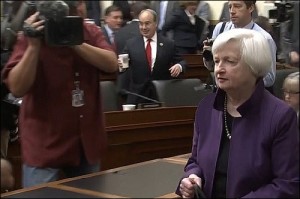Courtesy of Pam Martens
Janet Yellen Appears Before the House Financial Services Committee, November 4, 2015
Tomorrow, Janet Yellen will scurry over to the Rayburn House Office Building to give her semi-annual testimony to the House Financial Services Committee, now under the control of a deeply paranoid Republican majority when it comes to the Federal Reserve. (Not that some of that paranoia isn’t justified.) There is no question that Yellen will face hostile questioning from Republicans on the Committee, as she has in the past, although the questions tend to venture far afield from the real financial threats to U.S. stability.
Most Democrats, on the other hand, are so wedded to holding up the Dodd-Frank financial reform legislation as their grand achievement after the 2008 crash that they refuse to look out the window and see the equity capital of the Wall Street mega banks currently in a death spiral as the same banks invent ever more creative ways to loot the public and garner its distrust. With this fatal blind spot, House Democrats on the Committee are unlikely to fashion questions hinged to reality.
Thursday may hold out some promise, however. Yellen will present her semi-annual testimony to the Senate Banking Committee, beginning at 10 a.m. Since Republicans took control of the Senate in January 2015, this Committee has been chaired by Richard Shelby. Three Democrats well versed in Fed policy and the workings of Wall Street sit on the Committee: Senators Sherrod Brown, Elizabeth Warren and Jeff Merkley. Warren, in particular, has a penchant for zeroing in on hot button topics that produce nervous squirming from Yellen.
Back on July 15, 2014 when Yellen appeared before Senate Banking to present her semi-annual report, a tense exchange took place between Yellen and Warren. After reminding Yellen that Section 165 of Dodd-Frank mandated that the Wall Street mega banks had to submit annual, “credible” plans to the Fed explaining how they could be quickly liquidated if they got into trouble, rather than requiring another taxpayer bailout, Warren noted how massive some of these banks had become since the 2008 crash. Lehman Brother, said Warren, had $639 billion in assets and 209 subsidiaries when it failed in 2008 and it took three years to unwind the bank. Today, noted Warren, JPMorgan Chase has $2.5 trillion in assets and 3,391 subsidiaries. (The number of subsidiaries is likely a gross understatement since banks are now only required to report key subsidiaries.)
Yellen effectively buried herself by saying that the wind-down plans of some banks are “tens of thousands of pages.” That’s clearly not a “credible” plan since it’s hard to understand even a 100-page prospectus of Wall Street legalese let alone tens of thousands of pages.
…




